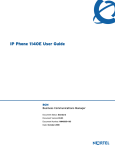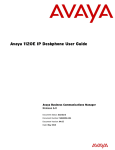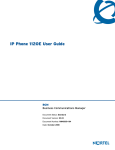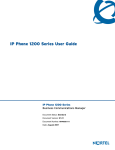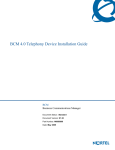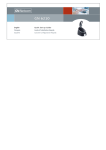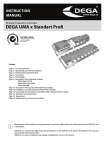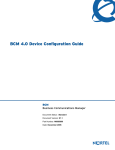Download 1140E IP Deskphone User Guide
Transcript
Avaya 1140E IP Deskphone User Guide
Avaya Business Communications Manager
Release 6.0
Document Status: Standard
Document Number: NN40050-105
Document Version: 04.01
Date: May 2010
© 2010 Avaya Inc.
All Rights Reserved.
Notices
While reasonable efforts have been made to ensure that the information in this document is complete and accurate at the time of printing,
Avaya assumes no liability for any errors. Avaya reserves the right to make changes and corrections to the information in this document
without the obligation to notify any person or organization of such changes.
Documentation disclaimer
Avaya shall not be responsible for any modifications, additions, or deletions to the original published version of this documentation
unless such modifications, additions, or deletions were performed by Avaya. End User agree to indemnify and hold harmless Avaya,
Avaya’s agents, servants and employees against all claims, lawsuits, demands and judgments arising out of, or in connection with,
subsequent modifications, additions or deletions to this documentation, to the extent made by End User.
Link disclaimer
Avaya is not responsible for the contents or reliability of any linked Web sites referenced within this site or documentation(s) provided by
Avaya. Avaya is not responsible for the accuracy of any information, statement or content provided on these sites and does not
necessarily endorse the products, services, or information described or offered within them. Avaya does not guarantee that these links will
work all the time and has no control over the availability of the linked pages.
Warranty
Avaya provides a limited warranty on this product. Refer to your sales agreement to establish the terms of the limited warranty. In
addition, Avaya’s standard warranty language, as well as information regarding support for this product, while under warranty, is
available to Avaya customers and other parties through the Avaya Support Web site: http://www.avaya.com/support
Please note that if you acquired the product from an authorized reseller, the warranty is provided to you by said reseller and not by Avaya.
Licenses
THE SOFTWARE LICENSE TERMS AVAILABLE ON THE AVAYA WEBSITE, HTTP://SUPPORT.AVAYA.COM/LICENSEINFO/
ARE APPLICABLE TO ANYONE WHO DOWNLOADS, USES AND/OR INSTALLS AVAYA SOFTWARE, PURCHASED FROM
AVAYA INC., ANY AVAYA AFFILIATE, OR AN AUTHORIZED AVAYA RESELLER (AS APPLICABLE) UNDER A
COMMERCIAL AGREEMENT WITH AVAYA OR AN AUTHORIZED AVAYA RESELLER. UNLESS OTHERWISE AGREED TO
BY AVAYA IN WRITING, AVAYA DOES NOT EXTEND THIS LICENSE IF THE SOFTWARE WAS OBTAINED FROM ANYONE
OTHER THAN AVAYA, AN AVAYA AFFILIATE OR AN AVAYA AUTHORIZED RESELLER, AND AVAYA RESERVES THE
RIGHT TO TAKE LEGAL ACTION AGAINST YOU AND ANYONE ELSE USING OR SELLING THE SOFTWARE WITHOUT A
LICENSE. BY INSTALLING, DOWNLOADING OR USING THE SOFTWARE, OR AUTHORIZING OTHERS TO DO SO, YOU,
ON BEHALF OF YOURSELF AND THE ENTITY FOR WHOM YOU ARE INSTALLING, DOWNLOADING OR USING THE
SOFTWARE (HEREINAFTER REFERRED TO INTERCHANGEABLY AS "YOU" AND "END USER"), AGREE TO THESE
TERMS AND CONDITIONS AND CREATE A BINDING CONTRACT BETWEEN YOU AND AVAYA INC. OR THE
APPLICABLE AVAYA AFFILIATE ("AVAYA").
Copyright
Except where expressly stated otherwise, no use should be made of the Documentation(s) and Product(s) provided by Avaya. All content
in this documentation(s) and the product(s) provided by Avaya including the selection, arrangement and design of the content is owned
either by Avaya or its licensors and is protected by copyright and other intellectual property laws including the sui generis rights relating
to the protection of databases. You may not modify, copy, reproduce, republish, upload, post, transmit or distribute in any way any
content, in whole or in part, including any code and software. Unauthorized reproduction, transmission, dissemination, storage, and or
use without the express written consent of Avaya can be a criminal, as well as a civil offense under the applicable law.
Third Party Components
Certain software programs or portions thereof included in the Product may contain software distributed under third party agreements
("Third Party Components"), which may contain terms that expand or limit rights to use certain portions of the Product ("Third Party
Terms"). Information regarding distributed Linux OS source code (for those Products that have distributed the Linux OS source code),
and identifying the copyright holders of the Third Party Components and the Third Party Terms that apply to them is available on the
Avaya Support Web site: http://support.avaya.com/Copyright.
Trademarks
The trademarks, logos and service marks ("Marks") displayed in this site, the documentation(s) and product(s) provided by Avaya are the
registered or unregistered Marks of Avaya, its affiliates, or other third parties. Users are not permitted to use such Marks without prior
written consent from Avaya or such third party which may own the Mark. Nothing contained in this site, the documentation(s) and
product(s) should be construed as granting, by implication, estoppel, or otherwise, any license or right in and to the Marks without the
express written permission of Avaya or the applicable third party. Avaya is a registered trademark of Avaya Inc. All non-Avaya
trademarks are the property of their respective owners.
Downloading documents
For the most current versions of documentation, see the Avaya Support. Web site: http://www.avaya.com/support
Contact Avaya Support
Avaya provides a telephone number for you to use to report problems or to ask questions about your product. The support telephone
number is 1-800-242-2121 in the United States. For additional support telephone numbers, see the Avaya Web site: http://
www.avaya.com/support
Contents
3
Contents
Chapter 1
About the Avaya 1140E IP Deskphone. . . . . . . . . . . . . . . . . . . . . . . . . . . . . . 5
Basic Features . . . . . . . . . . . . . . . . . . . . . . . . . . . . . . . . . . . . . . . . . . . . . . . . . . . . . . . . 5
Telephone Controls . . . . . . . . . . . . . . . . . . . . . . . . . . . . . . . . . . . . . . . . . . . . . . . . . . . . 7
Telephone Display . . . . . . . . . . . . . . . . . . . . . . . . . . . . . . . . . . . . . . . . . . . . . . . . . . . . 11
Chapter 2
Entering and editing text . . . . . . . . . . . . . . . . . . . . . . . . . . . . . . . . . . . . . . . . 13
Entering text using the telephone dialpad . . . . . . . . . . . . . . . . . . . . . . . . . . . . . . . . . . 13
Entering text using the USB keyboard . . . . . . . . . . . . . . . . . . . . . . . . . . . . . . . . . . . . . 13
Chapter 3
Configuring options. . . . . . . . . . . . . . . . . . . . . . . . . . . . . . . . . . . . . . . . . . . . 15
1. Preferences . . . . . . . . . . . . . . . . . . . . . . . . . . . . . . . . . . . . . . . . . . . . . . . . . . . . . . . 15
1. Display Settings . . . . . . . . . . . . . . . . . . . . . . . . . . . . . . . . . . . . . . . . . . . . . . . . 15
2. Language . . . . . . . . . . . . . . . . . . . . . . . . . . . . . . . . . . . . . . . . . . . . . . . . . . . . . 15
3. Bluetooth Setup . . . . . . . . . . . . . . . . . . . . . . . . . . . . . . . . . . . . . . . . . . . . . . . . . 16
2. Local Diagnostics . . . . . . . . . . . . . . . . . . . . . . . . . . . . . . . . . . . . . . . . . . . . . . . . . . 21
1. IP Set&DHCP Information . . . . . . . . . . . . . . . . . . . . . . . . . . . . . . . . . . . . . . . . . 21
2. Network Diagnostic Tools . . . . . . . . . . . . . . . . . . . . . . . . . . . . . . . . . . . . . . . . . 21
3. Ethernet statistics . . . . . . . . . . . . . . . . . . . . . . . . . . . . . . . . . . . . . . . . . . . . . . . 21
4. IP networks statistics . . . . . . . . . . . . . . . . . . . . . . . . . . . . . . . . . . . . . . . . . . . . . 21
5. USB device information . . . . . . . . . . . . . . . . . . . . . . . . . . . . . . . . . . . . . . . . . . . 21
3. Network Configuration . . . . . . . . . . . . . . . . . . . . . . . . . . . . . . . . . . . . . . . . . . . . . . . 21
4. Lock Menu . . . . . . . . . . . . . . . . . . . . . . . . . . . . . . . . . . . . . . . . . . . . . . . . . . . . . . . . 21
Chapter 4
Telephone setup. . . . . . . . . . . . . . . . . . . . . . . . . . . . . . . . . . . . . . . . . . . . . . . 23
Language choice . . . . . . . . . . . . . . . . . . . . . . . . . . . . . . . . . . . . . . . . . . . . . . . . . . . . . 23
Ring Type . . . . . . . . . . . . . . . . . . . . . . . . . . . . . . . . . . . . . . . . . . . . . . . . . . . . . . . . . . 23
Call log . . . . . . . . . . . . . . . . . . . . . . . . . . . . . . . . . . . . . . . . . . . . . . . . . . . . . . . . . . . . . 23
Time offset . . . . . . . . . . . . . . . . . . . . . . . . . . . . . . . . . . . . . . . . . . . . . . . . . . . . . . . . . . 23
About your programmable buttons . . . . . . . . . . . . . . . . . . . . . . . . . . . . . . . . . . . . . . . 24
Memory buttons . . . . . . . . . . . . . . . . . . . . . . . . . . . . . . . . . . . . . . . . . . . . . . . . . . 24
Program memory buttons . . . . . . . . . . . . . . . . . . . . . . . . . . . . . . . . . . . . . . . . . . . 24
Making a call . . . . . . . . . . . . . . . . . . . . . . . . . . . . . . . . . . . . . . . . . . . . . . . . . . . . . . . . 25
Answering a call . . . . . . . . . . . . . . . . . . . . . . . . . . . . . . . . . . . . . . . . . . . . . . . . . . . . . 26
While on an active call . . . . . . . . . . . . . . . . . . . . . . . . . . . . . . . . . . . . . . . . . . . . . . . . . 26
Placing a call on hold . . . . . . . . . . . . . . . . . . . . . . . . . . . . . . . . . . . . . . . . . . . . . . 26
Avaya 1140E IP Deskphone User Guide
4
Contents
Using handsfree . . . . . . . . . . . . . . . . . . . . . . . . . . . . . . . . . . . . . . . . . . . . . . . . . . . . . 26
Using a headset . . . . . . . . . . . . . . . . . . . . . . . . . . . . . . . . . . . . . . . . . . . . . . . . . . . . . . 26
Muting the Microphone . . . . . . . . . . . . . . . . . . . . . . . . . . . . . . . . . . . . . . . . . . . . . . . . 27
Accessing External Server Applications . . . . . . . . . . . . . . . . . . . . . . . . . . . . . . . . . . . 27
Index . . . . . . . . . . . . . . . . . . . . . . . . . . . . . . . . . . . . . . . . . . . . . . . . . . . . . . . . 29
NN40050-105
5
Chapter 1
About the Avaya 1140E IP Deskphone
The Avaya 1140E IP Deskphone brings voice and data to the desktop by connecting directly to a
Local Area Network (LAN) through an Ethernet connection.
Note: In this guide, user-defined feature key labels appear beside the keys, and
soft key labels appear directly above the keys.
Basic Features
Your Avaya 1140E IP Deskphone supports the following:
•
•
six user-defined feature keys with labels and indicators
four soft keys
Note: Some Avaya 1140E IP Deskphone phones are not configured to support
soft key functionality. Consult your system administrator.
•
•
•
•
•
•
•
•
graphical, high-resolution LCD display, backlit, with adjustable contrast
high-quality speaker phone
volume control keys for adjusting ringer, speaker, handset, and headset volume
four specialized feature keys:
— Directory
— Message/Inbox
— Shift/Outbox
— Services
six call-processing fixed keys:
— Mute
— Handsfree
— Goodbye
— Expand to PC
— Headset
— Hold
gigabit Ethernet ports
built-in gigabit Ethernet switch for shared PC access
headset jack with an On/Off key
Avaya 1140E IP Deskphone User Guide
6
Chapter 1 About the Avaya 1140E IP Deskphone
•
USB port to support a keyboard or mouse
Note: Powered downstream 1.1-complaint USB hubs are supported, including
USB 2.0 hubs, if they offer USB 1.1 backwards compliancy.
•
•
•
automatic network configuration
hearing-aid compatibility
wireless headset support using a Bluetooth® 1.2
compliant Audio Gateway
(Headset Profile, Bluetooth Power Class 2)
Caution: Do not plug the Avaya 1140E IP Deskphone into a regular telephone
jack. This results in severe damage to the IP Deskphone. Consult your system
administrator to ensure that you plug your telephone into a 10/100/1000BaseT
Ethernet jack
Caution: The Avaya 1140E IP Deskphone is designed for use in an indoor
environment only.
NN40050-105
Chapter 1 About the Avaya 1140E IP Deskphone
7
Figure 1 shows the Avaya 1140E IP Deskphone.
Figure 1 Avaya 1140E IP Deskphone
Telephone Controls
Note: Some Avaya 1140E IP Deskphones are equipped with optional key caps.
Text in parentheses indicates labels appearing on the key caps, for example,
(Services).
Fwd
Soft keys are located below the display
area. The LCD label above each key
changes based on the active feature. This
key has been programmed for call
forwarding.
Feature
The Feature key is located on the bottom
left of the display area and is used for
accessing different phone options such as
changing the ring type (Feature *6).
Avaya 1140E IP Deskphone User Guide
8
Chapter 1 About the Avaya 1140E IP Deskphone
The keys on either side of the display area
are user-defined feature keys, with labels
on the LCD display.
A steady LCD light beside a line (DN) key
indicates that the line is active. A flashing
LCD light indicates the line is on hold or the
feature is being programmed.
GrpCl Z
A steady LCD light beside a feature key
indicates that the feature is active. A flashing
LCD light indicates that the feature is being
programmed.
Use the Volume control buttons to adjust
the volume of the ringer, handset, headset,
speaker, and the Handsfree feature. Press
the top button to increase the volume, and
press the bottom button to decrease volume.
(Mute)
Press the Mute key to listen to the receiving
party without transmitting. Press the Mute
key again to return to two-way conversation.
The Mute key applies to handsfree, handset,
and headset microphones.
Note: The Mute LED indicator, located
on the Mute key, flashes to indicate that
the microphone is muted.
(Handsfree)
Press the Handsfree key to activate
handsfree.
Note: The Handsfree LED indicator,
located on the Handsfree key, lights to
indicate when handsfree is active.
Use the Navigation keys to scroll through
menus and lists appearing on the LCD
display screen. The outer part of this key
cluster rocks for up, down, left, and right
movements.
NN40050-105
Chapter 1 About the Avaya 1140E IP Deskphone
9
Use the Send/Enter key, at the center of the
Navigation key cluster, to confirm menu
selections.
In most menus, you can use the Send/Enter
key instead of the Select soft key.
(Hold)
(Expand)
(Headset)
Press the Hold key to put an active call on
hold. Tap the flashing line (DN) soft key to
return to the caller on hold.
Use the Expand to PC key to access
external server applications.
Press the Headset key to answer a call
using the headset or to switch a call from the
handset or handsfree to the headset.
Note: The Headset LED indicator,
located on the Handsfree key, lights to
indicate that the headset is in use.
(Headset)
(Headset)
(Goodbye)
Press the Headset key twice to open the
Bluetooth Setup menu.
Note: If Bluetooth wireless technology is
not enabled on your phone, this menu is
not available.
Use the Goodbye key to terminate an active
call.
When a message is waiting, the red Visual
Alerter/Message Waiting indicator flashes.
Also, when the ringer sounds, this indicator
flashes.
Avaya 1140E IP Deskphone User Guide
10
Chapter 1 About the Avaya 1140E IP Deskphone
When your Avaya 1140E IP Deskphone
firmware is being updated, the blue Feature
Status Lamp indicator flashes.
Note: To find out if additional features
are supported, contact your
administrator.
(Copy)
Programmable memory button.
(Default: Blank)
(Services)
Press the Services key to access the
scrollable Feature Display menu (FEATURE
*900), including the hot desking feature
(programmable memory button).
(Services)
Double-press the Services key to access
the Local Tools menu, and use the
navigation keys to access the following
items:
(Services)
•
1. Preferences
•
2. Local Diagnostics
•
3. Network Configuration
•
4. Lock Menu
Note: Your system administrator can
establish a password for the Tools
menu. If you attempt to access the Tools
menu and a dialog box appears
prompting you for a password, contact
your system administrator.
(Stop)
NN40050-105
Programmable memory button.
(Default: Blank)
Chapter 1 About the Avaya 1140E IP Deskphone
(Outbox)
11
Press the Express messaging key
(FEATURE 980; programmable memory
button) to send voice mail messages. For
more information about voice mail
messaging, refer to your CallPilot Quick
Reference Card.
Note: The functionality of the "shift"
feature is not supported by Avaya
Business Communications Manager or
by Survivable Remote Gateway (when in
local mode). This feature is reserved for
use exclusively for sets registered to
Avaya Communications server 1000
platforms.
(Inbox)
(Directory)
Press the Mailbox in key (programmable
memory button) to open your CallPilot
mailbox. For more information about mailbox
options, refer to your CallPilot Quick
Reference Card.
Programmable memory button.
(Default: Blank)
Telephone Display
Your Avaya 1140E IP Deskphone has three display areas:
•
•
•
The upper display area provides labels for the four user-defined feature keys.
The middle display area contains single-line information for items such as caller number,
caller name, feature prompt string, user-entered digits, date and time information, and
telephone information.
The lower display area provides labels for the four soft keys.
Avaya 1140E IP Deskphone User Guide
12
Chapter 1 About the Avaya 1140E IP Deskphone
Figure 2 shows an idle LCD screen.
Figure 2 Avaya 1140E IP Deskphone LCD screen
NN40050-105
13
Chapter 2
Entering and editing text
You can enter and edit text on your Avaya 1140E IP Deskphone using the following methods.
Which method you use for text entry or editing depends on the application. Table 1 shows the
applications and input devices that you can use for text entry.
Table 1 Application text entry
For:
Use:
Call Server-related applications
(for example, changing feature
key labels or dialing)
Dialpad
USB keyboard for numeric entries
only
USB keyboard
USB keyboard
Dialpad for numeric entries
Graphical applications
Local Tools menu
Entering text using the telephone dialpad
You can use the dialpad to enter text. For example, if you want to enter the letter A, press the
number 2 key once. If you want to enter the letter C, press the number 2 key three times.
Note: No letters are associated with the number 1 or 0 keys.
Entering text using the USB keyboard
You can use the USB keyboard, when connected, to enter text in the tools and graphical
applications.
For number entry in telephone applications (for example, when dialing), you can use the keyboard
to enter digits (0–9), as well as asterisk (*) and number sign (#). Other characters are not used.
When on a call, you can use the function keys (f1, f2, f3, f4, f5, f6, f7, and f8) to control the
telephone. Table 2 shows the function keys and their associated action during telephone calls.
Table 2 USB keyboard function keys during telephone calls
Function Key Action
f1
f2
f3
f4
f5
Go to Handsfree mode
Go to Headset mode
Place the current call on hold
Mute the current call
Volume up
Avaya 1140E IP Deskphone User Guide
14
Chapter 2 Entering and editing text
f6
f7
f8
NN40050-105
Volume down
Copy
Quit
15
Chapter 3
Configuring options
Note: Many of the options discussed in this section are for administrator use
only. Do not make any changes unless instructed by an administrator.
Your Avaya 1140E IP Deskphone has both local and server-based options. Two methods are
available to navigate in the Local Tools menu:
•
•
Follow the prompts on screen.
Where a menu entry has a number in front of it, you can select that entry by pressing the
associated key on the dialpad. For example, when you are in the Local Tools menu, you can
access 2. Local Diagnostics by pressing the 2 key on the dialpad.
Double-press the
options:
(Services) key to open the Local Tools Menu and access the following
1. Preferences
Use the Preferences menu item to configure local preferences.
1. Display Settings
Use the Contrast tool to alter the physical settings of the display. Use the Sleep tool to control how
long the display remains lit if the phone is inactive.
1
Double-press
2
Press the 1 key on the telephone dialpad to open the 1. Preferences menu, and press the 1 key
on the telephone dialpad to open the 1. Display Settings menu.
3
Press the Up/Down navigation keys to scroll and select either Contrast or Sleep. Press the
Select soft key.
4
Press the Up/Down navigation keys to increase or decrease the value.
5
Press the Exit soft key.
(Services) to open the Local Tools menu.
2. Language
Use the Language tool to select the language used on your phone.
1
Double-press
2
Press the 1 key on the telephone dialpad to open the 1. Preferences menu, and press the 2 key
on the telephone dialpad to open the 2. Language menu.
(Services) to open the Local Tools menu.
Avaya 1140E IP Deskphone User Guide
16
Chapter 3 Configuring options
3
Press the Up/Down navigation keys to scroll and highlight the desired language (for example,
German [Deutsche]).
4
Choose one of the following:
•
•
Press the Select soft key to save the desired language and return to the Telephone Options
menu.
Press the Cancel soft key to keep existing configurations.
5
Press the Exit soft key. Changes are saved automatically.
3. Bluetooth Setup
Your Avaya 1140E IP Deskphone is equipped with a Bluetooth wireless technology radio system
to support wireless headsets.
You can access the Bluetooth Setup options using either of the following two methods:
•
•
Double-press the Headset key to open the Bluetooth Setup dialog box. This method is used in
this document.
Double-press the Services key to open the Local Tools menu, press 1 on the dialpad to select
1. Preferences, and press 3 on the dialpad to open the 3. Bluetooth Setup dialog box.
Note: The Bluetooth Setup menu entry is not available on all phones. If the
Bluetooth Setup menu entry appears dimmed, or fails to open when you double
press the Headset key, the feature is not enabled on your phone. Before you can
use a wireless headset with your phone, the feature must be enabled by the system
administrator.
Contact your administrator to find out if Bluetooth wireless technology functionality is available
for your use.
Note: If Bluetooth wireless technology is enabled on your phone, and
password-protection for the Local Tools menu has been enabled, you can still
double-press the Headset key to access the Bluetooth Setup menu.
To pair the wireless headset with your phone:
1
Check with your administrator to ensure that Bluetooth wireless technology is available for
your use.
2
Double-press the
(Headset) key access 3. Bluetooth setup.
The Enable Bluetooth check box is highlighted.
Note: If the Bluetooth Setup menu fails to open when you double press
the Headset key, Bluetooth wireless technology is not enabled on your
phone.
NN40050-105
Chapter 3 Configuring options
17
3
Press the Enter key to activate Bluetooth wireless technology.
A check mark is displayed to indicate that the feature is activated. The message “BT Enabled”
appears at the bottom of the display.
4
Put your wireless headset in its pairing or search mode. The procedure for doing this can be
different for each wireless headset. Refer to the documentation that accompanied your
headset, or contact the vendor.
For example, if you are using the GN Netcom GN 6210, do the following:
5
a
Turn the headset off by pressing and holding the telephone button for 3 - 4 seconds until a
high to low tone is heard. The headset blue LED turns off.
b
Press and hold the telephone button for about 8 seconds until the blue LED flashes and
then lights steadily.
Search for (pair) the headset:
a
Press the Right navigation key twice to highlight the Search button, displayed next to the
Search Devices item.
b
Press the Enter key.
The message “Searching....” is displayed.
c
If the search is successful, a list of Bluetooth wireless devices appears in the Found:
combo box.
d
Choose one of the following:
— If the search is successful, proceed to step 6.
— If the search is not successful, the message "Search completed. No device found" is
displayed. Power off the wireless headset, and repeat steps 4 and 5.
6
When your headset is displayed in the Found: combo box, press the Stop soft key or wait for
the search to finish.
7
Choose one of the following:
•
•
If your headset is displayed in the Found: combo box, proceed to step 8.
If your headset is not displayed in the Found: combo box, select your headset from the list, as
follows:
a
Press the Right navigation key to navigate to the Found: combo box. Press the Enter key
to start the edit mode.
b
Press the Down navigation key to open the list. Press the Up/Down navigation keys to
scroll and highlight your headset.
c
Press the Enter key to select the headset and close the list. Press the Enter key to exit edit
mode.
Avaya 1140E IP Deskphone User Guide
18
Chapter 3 Configuring options
8
Press the Right navigation key to scroll in the list and highlight the Pair button (next to the Pair
Device item) and press the Enter key.
a
A dialog box appears that prompts you to "Enter PIN#".
b
Use the telephone dialpad to enter the headset PIN and press the Enter key.
Note: Check your headset's documentation to find its PIN (sometimes
called a passkey). Typically this value is 0000.
9
Choose one of the following:
•
If the headset is successfully paired with your phone, proceed to step 10. To verify that the
pairing was successful, ensure that the headset appears in the list next to the Paired: item. If
pairing is successful, the message "Pair completed" is also displayed at the bottom of the
screen.
If the headset is not successfully paired with your phone, an error message is displayed at the
bottom of the screen. If you get an error message:
— Confirm that the wireless headset is still in search/pair mode. For example, on the GN
Netcom GN 6210 headset the blue LED should still be lighted when the pairing
operation starts.
— If the headset timed out and exited search/pairing mode, put the headset in pairing
mode, as discussed in step 4, and repeat step 8.
— Check that you are using the correct PIN and repeat step 8.
•
10 Choose one of the following:
•
•
If your headset is displayed in the Paired: combo box, proceed to step 11.
If more than one device is paired, you may need to navigate to the one you want, as follows:
a
Press the Right navigation key to scroll in the list and highlight the Paired: combo box.
Press the Enter key to start the edit mode.
b
Press the Up/Down navigation keys to open the list. Press the Up/Down navigations key
to scroll in the list and highlight your headset.
c
Press the Enter key to select the headset and close the list.
Press the Enter key to exit edit mode.
11 Choose one of the following:
•
•
If only one headset is paired, proceed to step 12.
If more than one Bluetooth wireless headset is paired, the first headset paired is automatically
made the active device. To make a different headset active, do the following:
— Press the Right navigation key to scroll in the list and highlight the Set button (next to
the Set Active Device item).
— Press the Enter soft key.
The message "Set active: “device name”" is displayed. This means that the headset
named is now the active wireless headset and is used when you press the headset key.
NN40050-105
Chapter 3 Configuring options
19
12 Press the Exit soft key to close the Bluetooth Setup menu and return to the main display.
Changes are saved automatically.
Note: Avaya recommends that you not pair more than one headset of the
same model, because they have identical names in the Paired list.
Dual Pairing Headsets
Take special care when using a "dual pairing" type of Bluetooth wireless technology headset. The
GN Netcom GN6210 is an example of such a headset. It can be paired to its base as well as to the
Avaya 1140E IP Deskphone. If it is paired to both, the Avaya 1140E IP Deskphone is the second
device, and the following applies:
Press the headset "telephone" key:
•
•
If a single tone sounds, the headset is connected to the base.
If a double beep sounds, the headset is connected to the Avaya 1140E IP Deskphone.
If the base is powered off, the headset is only paired to the Avaya 1140E IP Deskphone and
pressing the "telephone" key connects you to the Avaya 1140E IP Deskphone.
Note: Unless you need to dual pair the GN6210 headset, operating the
headset with the Avaya 1140E IP Deskphone is simpler if it is only used
with its charging-only base. The desktop telephone base should be
powered off if it is not in use.
Interaction with wired headsets
If you connect a Bluetooth wireless technology headset and a wired headset to the same Avaya
1140E IP Deskphone, the two interact as follows:
•
•
If no wireless headset is paired, the wired headset works as normal. Likewise, if a wireless
headset is paired with the set, but is not in range, the wired headset works as normal.
If the Use BT headset check box is selected, the wireless headset is used as the phone headset.
— The Bluetooth wireless technology headset can work only if it is within range of the
phone; as the wireless headset approaches the edge of its radio range, the audio quality
degrades and radio interference noise increases. When the wireless headset is in
connecting range, the Headset key controls the wireless headset, even if a wired
headset is attached. If a wireless headset moves out of connecting range, a special
beep sounds in the headset indicating the connection was lost. For example, on the
GN6210, this is a series of tones, high to low, the same as the beeps that sound when a
call ends.
Avaya 1140E IP Deskphone User Guide
20
Chapter 3 Configuring options
When you do not want to use Bluetooth wireless technology
If a wireless headset is connected, and you want to use the wired headset, you can switch between
the two. It is not necessary to unpair or disable the Bluetooth wireless technology feature.
Note: You can switch between a wired and wireless headset and back
again either when the phone is idle or during an active call.
To switch between a wired headset and wireless headset:
1
Double-press the
2
Press the Left/Right navigation key to select the Use BT Headset item.
3
Press the Enter key to toggle this option on or off.
A check mark indicates that the wireless headset is used. Clear the check mark to use a wired
headset. On (o) by default.
(Headset) key to open the 3. Bluetooth Setup dialog box.
To unpair a Bluetooth wireless technology headset:
1
Double-press the
2
Press the Right navigation key to select the Paired: item.
3
Choose one of the following:
•
•
If your headset is displayed in the Paired combo box, proceed to step 5.
If more than one device is paired, and your headset is not already displayed in the Paired
combo box, do the following:
(Headset) key to open the 3. Bluetooth Setup dialog box.
a
Press the Right navigation key to select the Paired: combo box. Press the Enter key to
open edit mode.
b
Press the Up/Down navigation keys to open the list. Press the Up/Down navigations key
to scroll in the list and highlight your headset.
c
Press the Enter key to select the headset and close the combo box. Press the Enter key to
exit edit mode.
4
Press the Right navigation key to select the UnPair button (next to the UnPair Device item).
5
Press the Enter key.
Your wireless headset is unpaired and removed from the Paired: item's list.
Note: Your wireless headset is no longer paired with your phone, and the
wired headset can be used. To use the wireless headset again, you must
perform the pairing and activation procedure.
NN40050-105
Chapter 3 Configuring options
21
2. Local Diagnostics
1. IP Set&DHCP Information
The Network Configuration tool is used to view reports about IP set and DHCP operation. This
tool is for administrator use only.
2. Network Diagnostic Tools
The Network Diagnostic Tools menu contains tools that are used to diagnose network problems.
This menu is for administrator use only.
3. Ethernet statistics
The Ethernet statistics tool is used to view reports about Ethernet operation. This menu is for
administrator use only.
4. IP networks statistics
The IP networks statistics tool is used to view reports about network operation. This menu is for
administrator use only.
5. USB device information
The USB Devices tool provides information about any Universal Serial Bus (USB) devices that
you connect to your phone. Your Avaya 1140E IP Deskphone automatically detects USB devices
when you connect them to the USB port in the back of the telephone.
1
Double-press
2
Press the 5 key on the telephone dialpad to select 5. USB Devices.
USB Device information is displayed.
3
Press the Return soft key.
(Services) to open the Local Tools menu.
3. Network Configuration
The Network Configuration tool displays information that was configured when the telephone was
installed. This tool is for administrator use only.
4. Lock Menu
The lock menu tool is used by the system administrator to protect the Local Tools menu items
from accidental or unwanted changes.
Avaya 1140E IP Deskphone User Guide
22
Chapter 3 Configuring options
The lock menu tool is not available on all systems. If the menu entry appears dimmed, it is not
enabled on your phone. Contact your administrator to find out of this feature is available for your
use.
NN40050-105
23
Chapter 4
Telephone setup
Note: For more information about the features available to your telephone and
how to use them, refer to the BCM50 Telephone Features User Guide
(N0027160)
Language choice
Select the Primary Language for the telephone display.
Choose one of the following three options:
•
•
•
Press Feature *501. Select the Alternate Language for the telephone display.
Press Feature *502. Select the Alternate Language 2 for the telephone display.
Press Feature *503. Select the Alternate Language 3 for the telephone display.
Ring Type
To select the ring type for your telephone:
1
Press Feature *6.
2
Press 1, 2, 3, 4, or Next to hear the different ring types.
3
Press OK to store the ring type.
Call log
Press Feature *812 and use the navigation keys to scroll through and edit the call log.
Time offset
When your Avaya 1140E IP Deskphone is located in a different time zone than your system, the
display shows the system time instead of the local time. The Time Offset feature allows you to
adjust the time that appears on the display. Before you begin, calculate the time difference, in
hours, between the server time and local time.
Avaya 1140E IP Deskphone User Guide
24
Chapter 4 Telephone setup
To change the time that appears on your telephone display to
local time:
1
Press Feature *510.
2
Press Change.
3
Press * to switch between adding or subtracting time.
4
Using the dialpad, enter the number of hours between local time and system time.
Note: Press # to enter half-hour increments.
5
Press OK.
Note: It may take up to 1 minute for the change to appear on the display.
About your programmable buttons
Your System Administrator assigns the four programmable buttons as line, intercom, or memory
buttons. The label for each button appears on the display next to the button. For more information,
contact your System Administrator.
Memory buttons
These are buttons that are not assigned as line or intercom buttons. Memory buttons store internal
and external phone numbers or features to give you one-touch dialing or feature activation.
Program memory buttons
You can program a memory button with a new phone number or feature.
External autodial
1
Press Feature *1.
2
Press a memory button.
3
Dial the external phone number.
4
Press OK to store the phone number.
NN40050-105
Chapter 4 Telephone setup
25
Internal autodial
1
Press Feature *2.
2
Press a memory button.
3
Dial the extension number.
4
Press OK to store the extension number.
Features
1
Press Feature *3.
2
Press a memory button.
3
Press Feature and enter the feature code.
4
Press OK to store the feature code.
Erase memory buttons
1
Press Feature *1.
2
Press a memory button.
3
Press OK to erase the phone number saved on the button.
Making a call
There are many ways to place a call depending on your telephone programming and the type of
call.
Making external calls using line soft keys
1
Lift the handset.
2
Tap a line soft key.
3
Dial the external telephone number.
Making external calls using intercom soft keys
1
Lift the handset.
2
Tap an intercom soft key, and enter a line pool access code.
3
When you hear an external dial tone, dial the external telephone number.
Note: Contact your system administrator for a list of line pool codes. When
entering a line pool access code on PRI lines, you do not hear a dial tone.
Avaya 1140E IP Deskphone User Guide
26
Chapter 4 Telephone setup
Making internal calls using intercom soft keys
1
Lift the handset.
2
Tap an intercom soft key.
3
Dial the extension number.
Contact your system administrator for a list of extension numbers.
Answering a call
When your telephone rings and the light flashes, or when an intercom or line soft key indicator
flashes:
•
Lift the handset.
OR
•
Press the line or intercom soft key with the flashing S indicator before you lift the handset.
While on an active call
Placing a call on hold
Calls are put on hold automatically when you switch from one line to another.
•
•
(Hold). TheSindicator for the line on hold flashes.
While on a call, press
To retrieve a held call, tap the line soft key with the flashing Sindicator.
Using handsfree
Your System Administrator must program the Handsfree feature for your telephone.
•
•
Press
(Handsfree) to make or answer a call.
To switch to handsfree when you are on a handset call, press
(Handsfree) and replace
the handset. Lift the handset to switch back.
•
To switch to handsfree when you are on a headset call, press
Press
(Handsfree)
(Headset)to switch back.
Using a headset
You must have a headset installed on your telephone to use this feature.
•
Press
(Headset) to activate the headset mode. When the
press a line or intercom soft key to make a call.
NN40050-105
(Headset) light is on,
Chapter 4 Telephone setup
•
•
To switch to your headset when you are on a handset call, press
the handset. Lift the handset to switch back.
To switch to your headset when you are on a Handsfree call, press
(Handsfree) to switch back
27
(Headset) and replace
(Headset). Press
Muting the Microphone
You can use mute(
•
•
) on handset, handsfree, or headset calls.
While on a call, press
(Mute) to turn the microphone off. The
lights when the microphone is off.
Press
(Mute) again to turn the microphone on.
(Mute) button
Accessing External Server Applications
Use External Server Applications to access a variety of applications directly from your Avaya
1140E IP Deskphone.
To find out what features and services are available, contact your system administrator. Depending
on what is available on your system, your phone can provide information; for example, local news
and weather, stock market information, or traffic reports.
For more information about the External Server Applications, consult the Avaya IP Deskphone
External Server Applications User Guide.
Avaya 1140E IP Deskphone User Guide
28
Chapter 4 Telephone setup
NN40050-105
Index
29
Index
E
Expand to PC key 9
G
Goodbye key 9
H
Handsfree / Speaker key 8
Headset key 9
Hold key 9
L
Line (DN) key 8
M
Message waiting indicator 9
Mute key 8
N
Navigation keys 8
P
Programmable line/feature keys 8
S
Soft keys 7
V
Volume control 8
Volume control bar 8
Avaya 1140E IP Deskphone User Guide






























